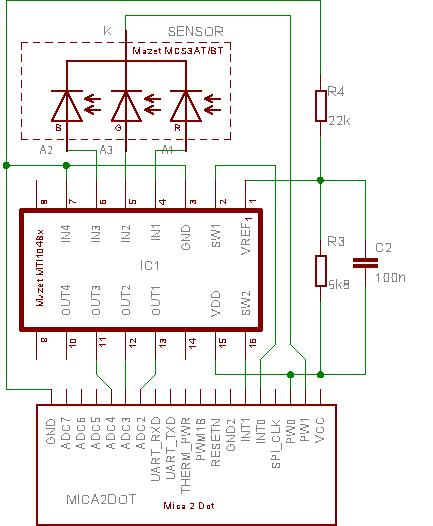
Wireless Color Sensor

Close to human perception and stable color sensing is a pervasive challenge encountered in various disciplines, such as machine vision for classification and recognition, as well as in intelligent systems like smart illumination systems in home or workplace environments. In particular, small, flexible, and preferably wireless modules and networks of sensor modules are required. This project developed a wireless color sensor based on MAZeT color sensors (MCS3AT, MCS3BT, MCSi) and MICA dot modules. An additional dot extension board and appropriate software were designed and implemented. The system was validated for typical color classification tasks, such as medical laboratory object recognition. Future work will explore the use of multiple wireless color-sensor modules as components for intelligent illumination systems in both machine vision and home applications. The information conveyed by color is of significant interest across various fields, including machine vision applications for quality assurance, object segmentation, classification, and general recognition tasks in intelligent engineering systems. For example, the classification of medical objects highlights the importance of color in the recognition process. For effective sensing activities, the stability or color constancy of the sensing element and module is crucial for overall system performance. A common issue in machine vision is the aging of light sources, leading to gradual performance degradation. Similarly, color sensors with insufficient long-term stability of their transfer characteristics can also present challenges. Additionally, the application in distributed embedded systems for Ambient Intelligence imposes further constraints on the physical size and communication of the desired sensor module. Minimum size and wireless communication are desirable features for a color-sensor module applicable to the aforementioned fields and needs. As such a system was not readily available, a project was initiated to design a module incorporating stable color sensor elements on an embedded platform suitable for Ambient Intelligence and other applications. MAZeT sensors (MCS3AT, MCS3BT, MCSi) were selected for their unique properties. The MICA system and MICA dot modules were chosen as the embedded system platform, which was also the common platform in a local Ambient Intelligence priority program that initiated the color-sensor module project. An extension board featuring a MAZeT transimpedance amplifier for the three color channels was designed for the MICA dot system. The output voltage range for the photo current from these amplifiers, which are fed to the local ADC of the MICA module sequentially, can be flexibly determined through programming. More details are available in the publication referenced below. The following schematic describes the color-sensor board circuit. This extension board was attached to a standard MICA dot mote. Software was developed by the system designer for both the mote and the base station, which communicates with the PC (TinyOS and Linux/Cygwin). The software was enhanced for the polling and reading of multiple distributed color-sensor modules. A basic validation of the hardware setup and the developed software was conducted using an LED-based light source with temporally changing color composition. After validating the system's operability, it was applied to a more realistic task of color classification, involving two series of 100 repeated measurements.
The wireless color sensor system consists of several key components designed to work cohesively for effective color sensing and application in intelligent systems. The MAZeT color sensors (MCS3AT, MCS3BT, MCSi) are at the core of the system, providing high precision in color detection due to their advanced sensing capabilities. These sensors utilize a transimpedance amplifier configuration to convert the photocurrent generated by incident light into a voltage signal, which is then processed by the MICA dot modules.
The MICA dot serves as the embedded platform, providing a compact and flexible environment for the sensor modules. The addition of an extension board allows for the integration of the MAZeT amplifiers, which facilitate the amplification of signals from the color sensors across three distinct channels (red, green, and blue). This design ensures that the system can maintain color constancy and stability, critical for reliable performance over time.
Communication between the sensor modules and the base station is achieved wirelessly, allowing for the deployment of multiple sensor units in various environments without the constraints of physical wiring. The software developed for the system enhances its functionality by enabling the polling and reading of data from multiple sensors simultaneously, making it suitable for complex applications such as intelligent lighting and machine vision.
The validation process employed an LED light source that varied in color, simulating real-world conditions for testing the sensor's response. The ability to conduct repeated measurements aids in assessing the system's accuracy and reliability in color classification tasks. This comprehensive approach ensures that the developed wireless color sensor system meets the requirements for future applications in Ambient Intelligence and other intelligent systems.Close to human perception and stable color sensing is an ubiquitous problem found in numerous disciplinces, e. g. , in machine vision for classification and recognition or in general intelligent systems, for instance for intelligent illumination systems in home or working environments.
In particular for systems and applications of Ambient Intelligenc e small, flexible, and preferably wireless modules and networks of such sensor modules are required. In this project, a wireless color sensor was developed based on MAZeT color sensors (MCS3AT, MCS3BT, MCSi) and MICA dot modules. An additional dot extension board and appropriate software was designed and implemented. The system was validated for typical color classification tasks, e. g. , for medical laboratory object recognition. Future work will consider the use of multiple wireless color-sensor modules as a component for intelligent illumination systems, both for machine vision as well as for home applications.
The information conveyed by color is of significant interest in numerous application fields, ranging from machine vision applications for quality assurance as well as object segmentation, classification and general recognition tasks of intelligent engineering systems. For instance, the classification of medical objects displayed below, which has been pursued in a separate project activity, shows clearly the issue and benefit of color for the recognition process.
For corresponding sensing activities, in particular, the stability or color constancy of the sensing element and module is decisive for the overall system performance. A common problem in machine vision is the aging of the applied light sources, which lead to a gradual degradation of system performance.
A similar problem can arise for color sensors with insufficient long-term stability of their transfer characteristics. In addition, the application in distributed embedded systems and applications, e. g. , for Ambient Intelligence, imposes further restrictions on the physical size and communication of an aspired sensor modul.
Minimum size as well as wireless communication would be desirable features for a color-sensor module applicable to the above outlined fields and needs. As a system with such characteristics was not available, a project was started to design such a module, incorporating appropriate stable color sensor elements on a embedded platform suitable for Ambient Intelligence as well as other applications.
With regard to their unique properties sensors from MAZeT where selected for the project (MCS3AT, MCS3BT, MCSi; ). As embedded system platform the MICA system and MICA dot modules ( ) where selected, which were also the common platform in a local Ambient Intelligence priority programme in the context of which our color-sensor module project was initiated.
An extension board with a MAZet transimpedance amplifier for the three color channels was designed for the MICA dot system. The output voltage range for the photo current range of these amplifiers, whiche are fed to the local ADC of the MICA-, module in a sequential fashion, is flexibly be determined by programming.
More details can be found in the publication enlisted below. The following schematic describes the color-sensor board circuit. This extension board was attached to a standard MICA dot mote. Software was developed by the system designer both for the mote as well as for the base station, that serves to communicate with the PC (TinyOS and Linux/Cygwin). The software was enhanced for the principle polling and reading of multiple distributed color-sensor modules.
A basic validation of the hardware setup and the developed software was carried out employing an LED-based light source with temporally changing color composition: After basic validation of the system`s operability, it was applied to a more realistic task of color classification. Two series of 100 repeated measurements for 🔗 External reference
The wireless color sensor system consists of several key components designed to work cohesively for effective color sensing and application in intelligent systems. The MAZeT color sensors (MCS3AT, MCS3BT, MCSi) are at the core of the system, providing high precision in color detection due to their advanced sensing capabilities. These sensors utilize a transimpedance amplifier configuration to convert the photocurrent generated by incident light into a voltage signal, which is then processed by the MICA dot modules.
The MICA dot serves as the embedded platform, providing a compact and flexible environment for the sensor modules. The addition of an extension board allows for the integration of the MAZeT amplifiers, which facilitate the amplification of signals from the color sensors across three distinct channels (red, green, and blue). This design ensures that the system can maintain color constancy and stability, critical for reliable performance over time.
Communication between the sensor modules and the base station is achieved wirelessly, allowing for the deployment of multiple sensor units in various environments without the constraints of physical wiring. The software developed for the system enhances its functionality by enabling the polling and reading of data from multiple sensors simultaneously, making it suitable for complex applications such as intelligent lighting and machine vision.
The validation process employed an LED light source that varied in color, simulating real-world conditions for testing the sensor's response. The ability to conduct repeated measurements aids in assessing the system's accuracy and reliability in color classification tasks. This comprehensive approach ensures that the developed wireless color sensor system meets the requirements for future applications in Ambient Intelligence and other intelligent systems.Close to human perception and stable color sensing is an ubiquitous problem found in numerous disciplinces, e. g. , in machine vision for classification and recognition or in general intelligent systems, for instance for intelligent illumination systems in home or working environments.
In particular for systems and applications of Ambient Intelligenc e small, flexible, and preferably wireless modules and networks of such sensor modules are required. In this project, a wireless color sensor was developed based on MAZeT color sensors (MCS3AT, MCS3BT, MCSi) and MICA dot modules. An additional dot extension board and appropriate software was designed and implemented. The system was validated for typical color classification tasks, e. g. , for medical laboratory object recognition. Future work will consider the use of multiple wireless color-sensor modules as a component for intelligent illumination systems, both for machine vision as well as for home applications.
The information conveyed by color is of significant interest in numerous application fields, ranging from machine vision applications for quality assurance as well as object segmentation, classification and general recognition tasks of intelligent engineering systems. For instance, the classification of medical objects displayed below, which has been pursued in a separate project activity, shows clearly the issue and benefit of color for the recognition process.
For corresponding sensing activities, in particular, the stability or color constancy of the sensing element and module is decisive for the overall system performance. A common problem in machine vision is the aging of the applied light sources, which lead to a gradual degradation of system performance.
A similar problem can arise for color sensors with insufficient long-term stability of their transfer characteristics. In addition, the application in distributed embedded systems and applications, e. g. , for Ambient Intelligence, imposes further restrictions on the physical size and communication of an aspired sensor modul.
Minimum size as well as wireless communication would be desirable features for a color-sensor module applicable to the above outlined fields and needs. As a system with such characteristics was not available, a project was started to design such a module, incorporating appropriate stable color sensor elements on a embedded platform suitable for Ambient Intelligence as well as other applications.
With regard to their unique properties sensors from MAZeT where selected for the project (MCS3AT, MCS3BT, MCSi; ). As embedded system platform the MICA system and MICA dot modules ( ) where selected, which were also the common platform in a local Ambient Intelligence priority programme in the context of which our color-sensor module project was initiated.
An extension board with a MAZet transimpedance amplifier for the three color channels was designed for the MICA dot system. The output voltage range for the photo current range of these amplifiers, whiche are fed to the local ADC of the MICA-, module in a sequential fashion, is flexibly be determined by programming.
More details can be found in the publication enlisted below. The following schematic describes the color-sensor board circuit. This extension board was attached to a standard MICA dot mote. Software was developed by the system designer both for the mote as well as for the base station, that serves to communicate with the PC (TinyOS and Linux/Cygwin). The software was enhanced for the principle polling and reading of multiple distributed color-sensor modules.
A basic validation of the hardware setup and the developed software was carried out employing an LED-based light source with temporally changing color composition: After basic validation of the system`s operability, it was applied to a more realistic task of color classification. Two series of 100 repeated measurements for 🔗 External reference





